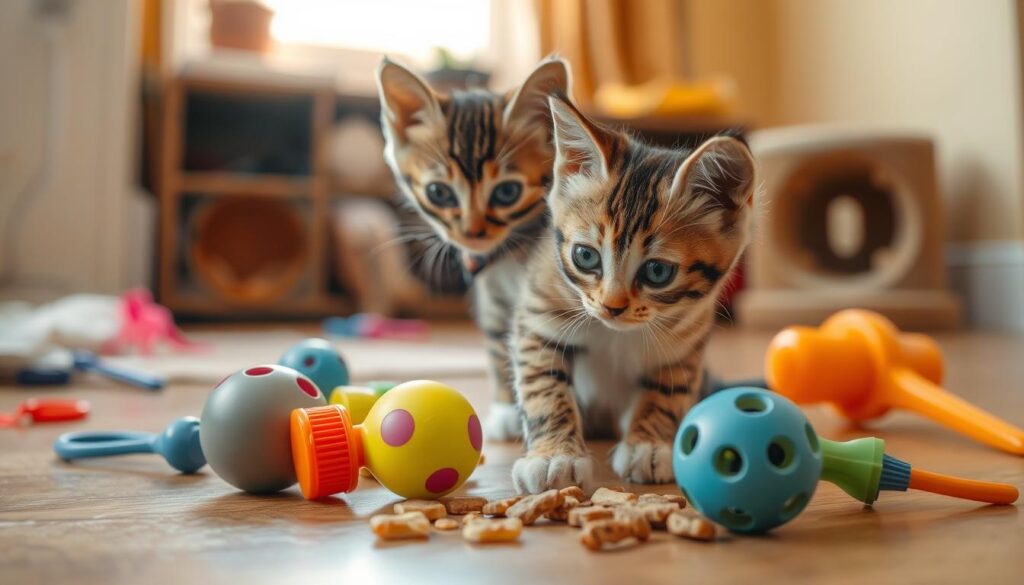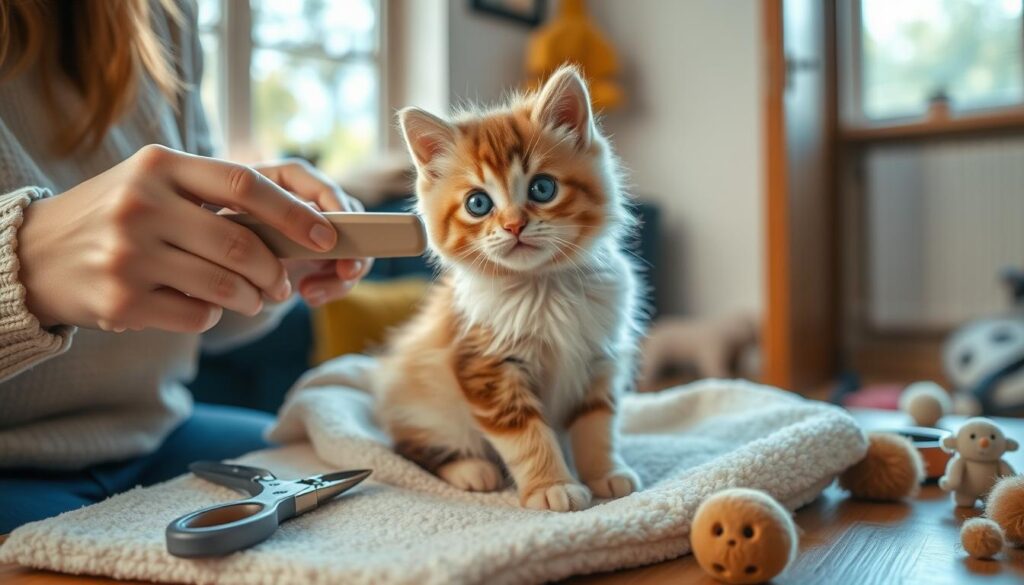When you bring home a 4 month old kitten, you start an amazing journey. Your little ball of fur is growing fast. They’re becoming more curious and energetic, entering key growth stages.
Your kitten is changing a lot at this age. They’re no longer helpless. Now, they’re exploring and showing their unique personality.
It’s important to understand these early months. Kittens are most open to new things between 2 to 7 weeks. So, your four-month-old is still learning a lot from you.
This guide will cover everything about caring for your kitten. We’ll talk about food, health, behavior, and bonding. We aim to help you enjoy this special time with your kitten.
Table of Contents
Understanding Your 4 Month Old Kitten
Your 4-month-old kitten is in an exciting stage. They are growing fast and showing new behaviors. They are moving from a tiny baby to a more independent young cat.

Developmental Milestones to Watch
At this age, your kitten will hit several important milestones:
- Increased coordination and agility
- Enhanced cognitive skills
- Rapid muscle and bone development
- Emerging personality traits
Social Behavior at Four Months
Learning social interactions is key for your kitten. At four months, they:
- Begin exploring boundaries
- Show more playful and curious behaviors
- Start understanding social hierarchies
- Develop stronger play and hunting instincts
“Every kitten is unique, but understanding their developmental stages helps create a stronger bond.”
Physical Changes in Your Kitten
Your kitten’s body will change a lot during this time. They will:
- Coat development: Transitioning to adult fur
- Stabilizing eye color
- Significant weight and height growth
- Emerging adult teeth
Knowing these milestones helps you care for your kitten better during this important time.
Nutrition Needs for Your Kitten
Caring for a young kitten means paying close attention to their diet. At four months, your kitten grows fast. Good nutrition is key for their health and happiness.
Best Food Choices for Growing Kittens
When picking food for your kitten, choose high-quality options made for young cats. Foods that meet AAFCO standards are best. They offer the nutrients your kitten needs to grow.
- Choose wet or dry kitten-specific food
- Ensure high protein content
- Select age-appropriate nutrition
Portion Sizes and Kitten Feeding Schedule
Feeding your kitten the right amount is important for their growth. Experts say kittens should eat small meals all day.
| Kitten Age | Meals per Day | Calories Needed |
|---|---|---|
| 4 months | 3-4 meals | 180-220 kcal/day |
Treats and Dietary Considerations
Use treats carefully in your kitten’s diet. Experts say treats should be less than 10% of their daily calories.
“Proper nutrition is the foundation of your kitten’s health and future development.” – Veterinary Nutrition Experts

Remember, balanced nutrition is vital for your kitten. Talk to your vet to make the best feeding plan for your kitten.
Ideal Living Environment for Kittens
Creating a safe and nurturing home for your 4-month-old kitten is key. It’s not just about food and shelter. It’s about making a space that sparks their curiosity and keeps them safe.

Kittens love to explore. They need a space that supports their growth and keeps them away from harm.
Creating a Safe Space at Home
Setting up a safe home for your kitten is important. Think about these key points for kitten playtime:
- Remove small objects that could be swallowed
- Secure electrical cords and loose wires
- Close off dangerous areas like washing machines and dryers
- Install child-proof latches on cabinets
Essential Supplies You Need
| Supply Category | Recommended Items |
|---|---|
| Sleeping Area | Soft bed, warm blanket, cozy cat cave |
| Play Equipment | Interactive toys, scratching post, climbing tree |
| Feeding Supplies | Ceramic food and water bowls, elevated feeding station |
| Hygiene | Litter box, litter scoop, multiple litter locations |
Enrichment Activities for Playtime
Stimulating activities are vital for your kitten’s growth. Kitten playtime activities should include:
- Puzzle toys that challenge their problem-solving skills
- Wand toys for interactive play
- Rotating toy selection to maintain interest
- Short, frequent play sessions
“A bored kitten is a destructive kitten. Provide plenty of engaging activities to keep them happy and healthy.” – Veterinary Behavior Specialists
Every kitten is different. Watch what they like and adjust their space to keep them happy, safe, and loved.
Health Care Essentials for Kittens
Caring for a young kitten means paying close attention to their health. Regular vet visits are key in the first months to help them grow right.

Kitten health check-ups are more than just routine. They let you keep an eye on your kitten’s health and stop problems early.
Importance of Veterinary Check-ups
At your first vet visits, you’ll get a full check-up. This includes:
- Physical body assessment
- Weight and growth monitoring
- Dental health evaluation
- Parasite screening
Vaccination Schedule Overview
Your 4-month-old kitten needs certain vaccines to stay safe. Vets suggest a plan that includes:
- Rabies vaccine
- Feline distemper protection
- Feline herpesvirus vaccine
- Calicivirus immunization
Spaying or Neutering Considerations
Spaying or neutering is vital for young kittens. Most vets say to do it between 4-6 months. It helps in many ways, like:
- Preventing unwanted litters
- Reducing risk of certain cancers
- Minimizing aggressive behaviors
- Supporting long-term health
“Prevention is always better than cure in kitten healthcare.” – Veterinary Professionals
Being proactive about your kitten’s health ensures a happy, healthy pet.
Training Your 4 Month Old Kitten
Training a 4-month-old kitten needs patience, consistency, and understanding. This stage is great for teaching kitten behavior tips and starting socialization.

Basic Commands and Socialization Techniques
Kittens at four months are eager to learn. Begin with simple commands like responding to their name and basic interactions. Good kitten socialization includes:
- Positive reinforcement with treats
- Short, engaging play sessions
- Gentle handling and touch
- Exposure to different sounds and environments
Litter Box Training Tips
Consistent litter box training is key to avoid future problems. Put the litter box in a quiet, easy-to-reach spot. Reward your kitten right after they use it to encourage good behavior.
| Training Technique | Success Rate | Duration |
|---|---|---|
| Positive Reinforcement | 85% | 2-3 weeks |
| Consistent Placement | 90% | Ongoing |
| Frequent Cleaning | 95% | Daily |
Dealing with Common Behavioral Issues
Common kitten problems include scratching furniture and meowing too much. Fix these by:
- Providing scratching posts
- Redirecting unwanted behaviors
- Using pheromone diffusers
- Creating structured play routines
“Patience and consistent training are the keys to a well-behaved kitten.” – Feline Behavior Experts
Remember, each kitten is unique. Tailor your training to fit their personality and needs.
Grooming Your Kitten Properly
Caring for a young kitten means learning key grooming skills. These skills help their health and growth. A regular grooming routine builds trust and keeps them looking and feeling good.

Bathing Techniques for Kittens
Most cats are clean and don’t need baths often. Kittens usually groom themselves well. But, they might need a bath if they’re very dirty or got something sticky on them. Here’s how to bathe them:
- Choose a warm, draft-free room
- Use lukewarm water
- Select a kitten-specific mild shampoo
- Speak softly to keep the kitten calm
- Rinse thoroughly to prevent skin irritation
Brushing and Maintaining Coat Health
Brushing is key for your kitten’s coat. Different coats need different grooming.
| Coat Type | Brushing Frequency | Recommended Tools |
|---|---|---|
| Short-haired | Once a week | Soft-bristled brush |
| Long-haired | 2-3 times a week | Slicker brush |
Nail Clipping Tips and Tricks
Nail care is vital for kittens. Start nail trimming early to make them comfortable. Here’s how:
- Use specialized cat nail clippers
- Trim nails every 2-4 weeks
- Cut only the white tip, avoiding the pink quick
- Reward your kitten with treats during and after trimming
“Gentle, consistent grooming helps build a strong bond between you and your kitten.” – Veterinary Grooming Experts
Grooming is more than looks. It’s a chance to check for skin problems, parasites, or health changes in your kitten.
Introducing Your Kitten to Other Pets
Bringing a new kitten into a home with pets needs careful planning and patience. It’s important to socialize your kitten well to ensure a peaceful home. How you introduce them can greatly affect the outcome.

Tips for Gradual Introductions
For a smooth introduction, start slow and controlled. Here are some steps to follow:
- Begin with scent exchange using blankets or toys
- Create separate safe spaces for each pet
- Use baby gates to provide visual contact without direct interaction
- Schedule short, supervised meeting sessions
Monitoring Interactions and Signs of Stress
Keep an eye out for stress signs during introductions. Common signs include:
- Flattened ears
- Hissing or growling
- Defensive body posturing
- Excessive hiding
“Patience is the key to successful pet introductions” – Veterinary Behaviorist
Ensuring a Harmonious Household
To keep your home peaceful, allocate resources wisely. Each pet should have:
- Separate food and water bowls
- Individual litter boxes
- Multiple resting areas
- Personal play zones
Positive reinforcement is key in socializing your kitten. Use treats and praise for calm interactions. Remember, integrating pets can take time, so stay patient and consistent.
Understanding Your Kitten’s Communication
Learning how your kitten talks is key to a strong bond. At four months, kittens show their feelings through body language and sounds. Knowing how to read these cues makes you a better pet parent.

Body Language Signals to Recognize
Kittens tell a lot through their body language. Here are important signs to look out for:
- Tail position shows their mood
- Upright tail with a slight curve: Happiness and confidence
- Puffed-up tail: Fear or aggression
- Tucked tail: Anxiety or submission
- Ear movements show their feelings
- Forward-facing ears: Curiosity and attention
- Flattened ears: Potential threat or discomfort
Vocalizations: What They Mean
Understanding your kitten’s sounds is part of caring for them. Different meows and sounds mean different things:
- Short meows: Greeting or seeking attention
- Prolonged meows: Potential discomfort or hunger
- Chirping sounds: Excitement or attempt to communicate
*Interesting fact*: About 50% of cat owners say their pets have unique voices.
Building Trust Through Interaction
Trust is crucial in your kitten’s life. Gentle, regular interactions build a strong bond. Play, speak softly, and answer their calls to grow closer.
Every kitten is different. Be patient and watchful to understand their special way of communicating.
Creating a Routine for Your Kitten
It’s important to have a regular routine for your 4-month-old kitten. A set schedule gives them security, lowers stress, and helps them develop good habits. By following a predictable feeding schedule and playing with them regularly, you’ll make a loving home for your kitten.
Importance of Consistency in Care
Cats love knowing what to expect. A routine makes them feel safe and less stressed. Studies show that kittens need structure to grow confident and behave well. Your consistent care will help your kitten understand what’s expected and feel secure.
Daily Activities to Incorporate
- Morning feeding and playtime
- Mid-day enrichment activities
- Evening feeding and calm interaction
- Regular litter box maintenance
Keeping a Schedule for Health and Play
Kittens need short play sessions all day. Vets suggest two 10-15 minute play sessions to keep them active and sharp. It’s important to balance play, rest, and eating for your kitten’s growth.
| Time | Activity | Duration |
|---|---|---|
| 7:00 AM | Morning Feeding | 15 minutes |
| 8:00 AM | Playtime | 10-15 minutes |
| 12:00 PM | Midday Feeding | 15 minutes |
| 3:00 PM | Interactive Toys | 10 minutes |
| 6:00 PM | Evening Feeding | 15 minutes |
| 8:00 PM | Quiet Bonding Time | 20 minutes |
“Routine is the foundation of a happy, healthy kitten.” – Veterinary Experts
Every kitten is different. You might need to change your schedule to fit your kitten’s needs and energy. Being patient and watching your kitten will help you find the best routine for them.
Choosing the Right Toys for Your Kitten
Kitten playtime activities are key for your young cat’s growth and happiness. At four months old, your kitten is full of energy and curiosity. Choosing the right toys is vital for their care.

Types of Toys That Stimulate Play
Various toys can spark your kitten’s natural hunting drive. They also boost physical and mental health. Here are some top picks:
- Interactive Wand Toys: The Frisco Bird with Feathers Teaser Wand Toy got a perfect score
- Puzzle Toys: The Trixie Activity Board scored 9/10 for interactive play
- Catnip Toys: Canvas catnip toys got a high rating of 9/10
- Window Teaser Toys: KONG Window Teaser keeps your kitten engaged for up to 15 minutes
Safety Considerations for Toy Selection
Choose durable and safe toys. Research shows 90% of toys might not interest your kitten. So, pick wisely.
| Toy Type | Safety Rating | Engagement Level |
|---|---|---|
| Feather Wand | High | 10/10 |
| Catnip Toy | Medium | 9/10 |
| Treat Puzzle | High | 8/10 |
DIY Toy Ideas for Fun
Making your own toys is a great way to keep your kitten entertained without spending a lot. Here are some easy ideas:
- Crinkly paper balls
- Cardboard box tunnels
- Sock puppet with bells
- Paper bag play area
Remember, the best toy is one that sparks your kitten’s imagination and keeps them active and entertained!
By picking toys that fit your kitten’s play style, you support their growth. You also create special memories together.
Socialization Beyond Your Home
It’s key to help your kitten grow socially between 4-6 months. This time is perfect to shape their future behavior and confidence. You can do this with the right kitten socialization techniques.
Introducing your kitten to different places helps them adapt and lowers anxiety. It’s all about making these experiences positive and controlled. This supports their emotional growth.
Benefits of Exploring New Environments
- Builds confidence in different settings
- Reduces fear responses to novel stimuli
- Encourages mental stimulation
- Develops problem-solving skills
Meeting New People and Animals Safely
Here’s how to safely introduce your kitten to new people or pets:
- Start with short, supervised interactions
- Use treats to create positive associations
- Watch for stress signals
- Allow the kitten to approach at their own pace
“Patience is the secret to successful kitten socialization.” – Veterinary Behaviorist
The Role of Socialization in Behavior
Proper socialization in the first 4-5 months greatly affects your kitten’s behavior later on. By slowly introducing new things, you help them become a well-adjusted adult cat.
Using pheromone diffusers can also help. They make the environment calm, reducing stress and making new experiences more comfortable for your kitten.
Dealing with Health Concerns in Kittens
Caring for a young kitten means keeping a close eye on their health. As a kitten parent, knowing about health risks and how to prevent them is key. This helps protect your kitten’s health for years to come.
Common Illnesses and Symptoms to Watch For
Vets say it’s important to watch for certain symptoms during kitten health check-ups. These signs could mean there’s a health problem:
- Persistent lethargy or sudden lack of energy
- Changes in appetite or water consumption
- Unusual respiratory sounds or difficulty breathing
- Digestive problems like vomiting or diarrhea
- Unexplained weight loss or gain
When to Contact Your Veterinarian
It’s important to know when to call the vet for your kitten. You should get help right away if you see:
- Body temperature exceeding 104°F
- Signs of disorientation
- Reddened gums
- Seizures or collapse
- Prolonged inability to walk or stand
“Early detection and intervention can significantly improve your kitten’s chances of recovery and long-term health.”
Preventative Health Measures
There are steps you can take to lower health risks for your kitten:
- Schedule regular wellness examinations
- Maintain updated vaccination records
- Implement consistent deworming protocols
- Monitor environmental temperature
- Provide balanced nutrition specific to kitten developmental stages
Remember, prevention is always better than cure when it comes to kitten health check-ups and overall care.
Preparing for Your Kitten’s Transition to Adulthood
As your kitten gets closer to four months, big changes will happen. They will move from being a playful kitten to a young cat. This brings new milestones and care needs.
Your kitten’s journey to adulthood includes many important changes. Knowing what to expect helps you care for them best during these key times.
What Changes to Expect Beyond Four Months
At this stage, your kitten will see fast physical and behavior changes:
- Increased muscle development
- More refined motor skills
- Enhanced cognitive abilities
- Potential growth spurts
Adjusting Care as Your Kitten Grows
Your care for your kitten must change as they grow. Nutrition becomes increasingly important. Their diet needs will shift to support their growth and development.
“Proper nutrition and care during these months set the foundation for a healthy adult cat.” – Veterinary Nutrition Experts
Lifelong Care Considerations
Good habits now help your cat’s health for life. Regular vet visits, balanced food, and mental play are key for kitten care.
- Schedule routine health screenings
- Maintain consistent feeding schedules
- Provide ongoing socialization opportunities
- Monitor weight and physical development
By understanding and adapting to your kitten’s growth, you’ll support their healthy development. This also strengthens your bond.
Tips for Traveling with Your Kitten
Traveling with a young kitten needs careful planning. It can be tough, but with the right steps, you can keep your kitten happy and stress-free.
Preparing Your Kitten for Travel
Begin by getting your kitten used to their carrier early. Use these tips to make the carrier a good place:
- Place favorite blankets or toys inside the carrier
- Leave the carrier open at home for exploration
- Offer treats inside the carrier to create positive associations
Safety Tips During Transit
Each travel method needs special care. Here’s a quick guide for flying:
| Airline | Pet Fee | Carrier Size |
|---|---|---|
| American Airlines | $150 each way | 18″ x 11″ x 11″ |
| Delta Airlines | $95 each way | 18″ x 11″ x 11″ |
| JetBlue | $125 each way | 17″ x 12.5″ x 8.5″ |
“Preparation is key to a successful journey with your kitten.” – Veterinary Travel Expert
Settling In After Travel
When you arrive, help your kitten settle by:
- Providing a quiet, secure space
- Maintaining familiar feeding schedules
- Offering comfort items from home
Pro tip: Bring a small portable litter box and familiar food to minimize stress during your travels. Most cats return to normal eating habits within 24 hours of arriving at a new location.
Building a Bond with Your 4 Month Old Kitten
Creating a strong bond with your 4-month-old kitten takes patience and understanding. Kitten behavior tips show that trust grows through positive experiences. These make your kitten feel safe and loved.
Activities to Strengthen Your Relationship
Building a bond means doing fun and comforting things together. Here are some kitten socialization techniques to help:
- Interactive play sessions with wand toys
- Gentle grooming routines
- Quiet cuddle time
- Treat-based training
Importance of Patience and Understanding
Every kitten is different. Respect your kitten’s boundaries and let the bond grow naturally. Don’t push for too much attention or interaction.
Recognizing Signs of Affection
Your kitten shows love in small ways. Look out for these signs:
- Purring during close contact
- Kneading with soft paws
- Bringing toys to you
- Sleeping near or on you
“The bond between a kitten and its human is built on trust, respect, and understanding.” – Veterinary Behaviorist
By following these kitten behavior tips and socialization techniques, you’ll form a strong bond with your kitten.
Addressing Common Kitten Behavior Problems
Caring for a young kitten means understanding and managing different behaviors. Tips for kitten behavior can help you handle these early stages with confidence and patience.
Young kittens go through many emotional and behavioral changes. These can be tough for pet owners. Up to 70% of these issues come from not socializing them enough. So, acting early is very important.
Solution Strategies for Aggression
Kittens can be aggressive due to too much energy or bad play training. Here are some key strategies:
- Redirect aggressive play to the right toys
- Use play sessions to help them burn energy
- Avoid using hands as play objects
- Stick to consistent training methods
Dealing with Scratching and Clawing
Scratching is natural for kittens. Give them many scratching posts and use positive rewards to guide them.
| Scratching Behavior Management | Recommended Action |
|---|---|
| Inappropriate scratching | Redirect to scratching post |
| Furniture protection | Use deterrent sprays |
| Nail trimming | Regular gentle trimming |
Managing Anxiety and Stress During Change
“Socialization is key to reducing fear and anxiety in young pets.” – Veterinary Behavioral Experts
Kittens get stressed during changes. Keep things calm by sticking to routines and providing safe spots. About 40% of pets get anxious during changes, so be gentle and patient.
- Make a daily schedule and stick to it
- Give them soft bedding for comfort
- Use calming pheromone diffusers
- Keep quiet, peaceful areas
Remember, every kitten is different. If you need help, talk to a behaviorist. They can give you specific advice for your kitten’s behavior.
Conclusion: A Happy and Healthy Kitten
Raising a 4 month old kitten is an exciting journey. It’s filled with love, learning, and growth. Your commitment to caring for a young kitten creates a strong foundation for a lifelong bond. Each stage of development brings unique challenges and rewards that will help your feline companion thrive.
Understanding your kitten’s developmental milestones is crucial. During the 3-6 month period, your kitten will begin exploring social dynamics and establishing their place in your household. This crucial time requires patience, consistent training, and plenty of positive interactions to shape their behavior and build trust.
Nurturing Your Kitten’s Potential
Your dedication to providing proper nutrition, healthcare, and enrichment will set the stage for a healthy adult cat. Remember that indoor cats typically enjoy longer lifespans and reduced health risks. By focusing on environmental stimulation, balanced diet, and regular veterinary care, you’re giving your 4 month old kitten the best possible start in life.
Embracing the Journey
Each day with your kitten is an opportunity to create lasting memories. Stay patient, attentive, and committed to understanding their unique personality. Your love and care will transform your young companion into a confident, well-adjusted feline friend who will bring joy to your home for years to come.

